PRINCE2® PROCESSES – Initiating a Project (IP)
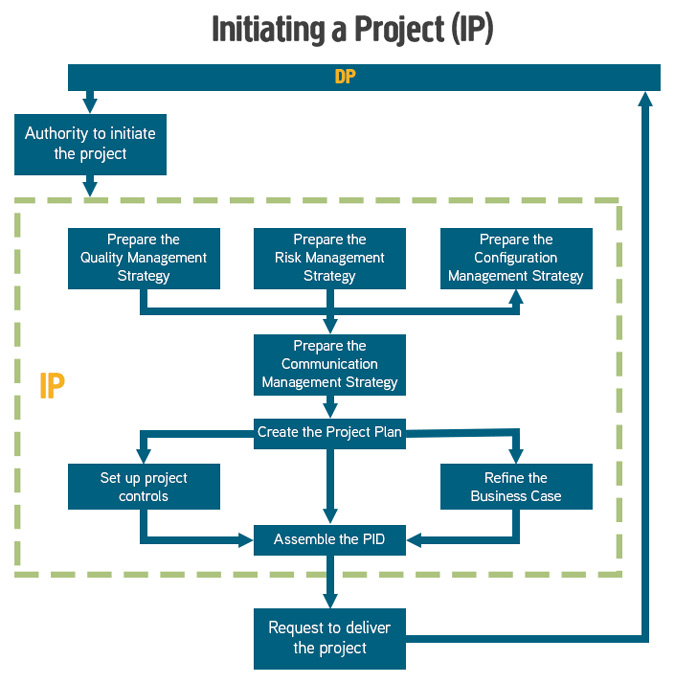
See our training for PRINCE2.
The purpose of the Initiating a Project process is to establish solid foundations for the project, enabling the organisation to understand the work that needs to be done to deliver the project’s products before committing to a significant spend.
The objective of the Initiating a Project process is to ensure that there is a common understanding of:
- The reasons for doing the project, the benefits expected and the associated risks
- The scope of what is to be done and the products to be delivered
- How and when the project’s products will be delivered and at what cost
- Who is to be involved in the project decision making
- How the quality required will be achieved
- How baselines will be established and controlled
- How risks, issues and changes will be identified, assessed and controlled
- How progress will be monitored and controlled
- Who needs information, in what format, and at what time
Other products created and ready for use when the project commences are:
- Risk Management Strategy and Risk Register
- Configuration Management Strategy, Initial Configuration Item Records and Issue Register
- Quality Management Strategy and Quality Register
- Communication Management Strategy
- Project Controls
- Role Descriptions
- Project Management Team Structure
- Project Plan
- Product Descriptions
- Benefits Review Plan
- Detailed Business Case
- Project Initiation Documentation
Andy Trainer
12 Jul 2007
PRINCE2® PROCESSES – Directing a Project (DP)
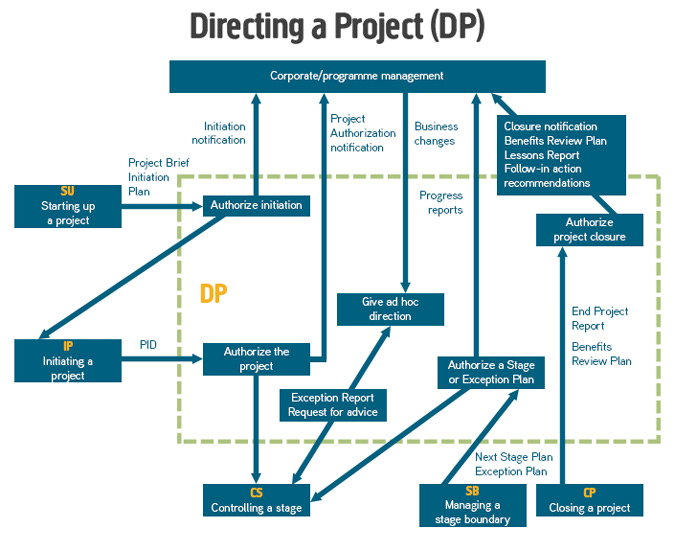
The purpose of the Directing a Project process is to enable the Project Board to be accountable for the project’s success by making key decisions and exercising overall control while delegating day-to-day management of the project to the Project Manager.
The objective of the Directing a Project process is to ensure that:
- There is authority to initiate the project
- There is authority to deliver the project’s products
- Management direction and control are provided throughout the project’s life, and that the project remains viable
- Corporate or programme management has an interface to the project
- There is authority to close the project
- Plans for realising the post-project benefits are managed and reviewed.
The Directing a Project process starts on completion of the Starting up a Project process and is triggered by the request to initiate a project.
The PRINCE2 processes are covered in detail in our PRINCE2 Foundation course and PRINCE2 Practitioner training courses.
Andy Trainer
12 Jul 2007
We decided that PRINCE2® diagrams could do with a freshen up so we've created an easy to read, standardised set of diagrams covering the 7 PRINCE2 processes to help learn PRINCE2.
Starting with the PRINCE2 Process Model and then breaking it down into each of the 7 processes.
If you've ever searched Google for 'PRINCE2 diagrams' you will know that it's not a pretty sight, and a lot of those diagrams are either too plain or impossible to decipher.
Our set of diagrams makes the PRINCE2 processes easier to understand by complimenting your PRINCE2 pre-course work and manual when preparing for your PRINCE2 Practitioner Exam.
PRINCE2 Process Model
PRINCE2 describes the steps of project management in seven processes. Any PRINCE2 project will need to address each of the processes but the extent of the application of a process should be decided on a project by project basis.
The PRINCE2 Process Model below describes the relationship between the seven processes:
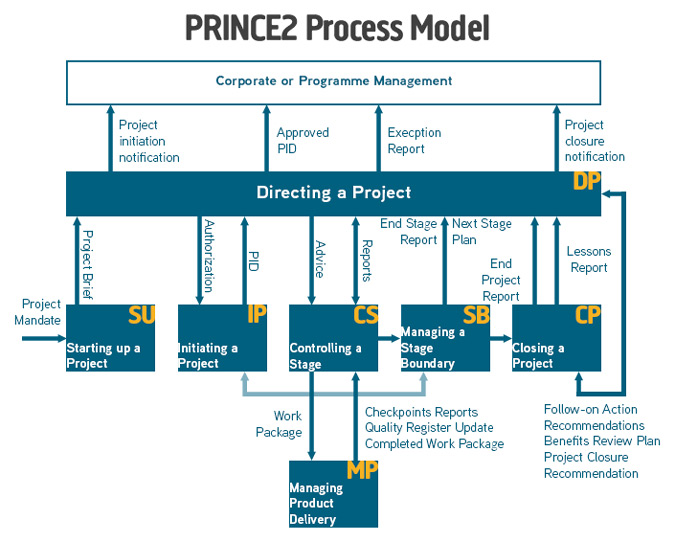
Andy Trainer
4 Jul 2013
Starting out in the world of Project Management can be a daunting experience for anyone. With so many terms, methods and variations to deal with, getting to grips with everything can be a real struggle.
For those new to Project Management, our Introduction to Project Management Training and our PRINCE2 Courses are a great place to start but there are also plenty of online resources available to help make things easier for you.

YouTube is one of those resources. There's something about videos which help to clarify and simplify complex ideas but wading through YouTube to find the best guides to Project Management isn't exactly the most interesting of tasks.
Luckily, we've done it so you don't have to and so here are our top ten Project Management videos aimed at those just starting out. We've everything from the very basics through to introducing the various methodologies and a fun one at the end.
Enjoy!
Andy Trainer
3 Jun 2013
PRINCE2® PROCESSES – Managing Product Delivery (MP)
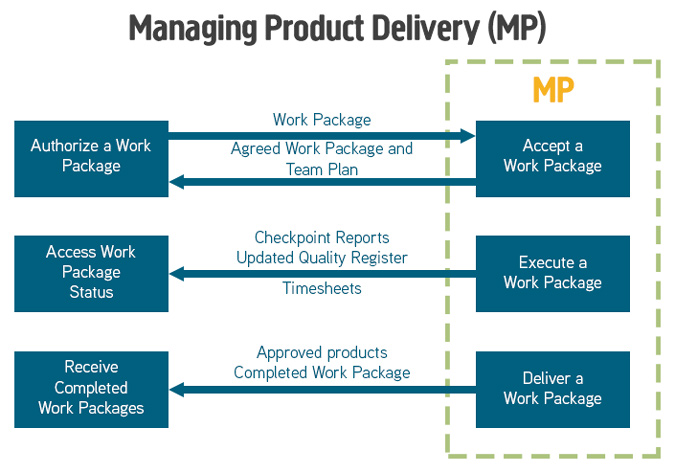
The purpose of the Managing Product Delivery process is to control the link between the Project Manager and the Team Manager(s), by placing formal requirements on accepting, executing and delivering project work.
The role of the Team Manager(s) is to coordinate an area of work that will deliver one or more of the project’s products. They can be internal or external to the customer’s organisation.
The objective of the Managing Product Delivery process is to ensure that:
- Work on products allocated to the team is authorised and agreed.
- Team Managers, team members and suppliers are clear as to what is to be produced and what is the expected effort, cost or timescales.
- The planned products are delivered to expectations and within tolerance.
- Accurate progress information is provided to the Project Manager at an agreed frequency to ensure that expectations are managed.
Products that are created or updated during this process are:
- Team plans with actual dates.
- Risk register with any identified work package level risks.
- Quality register with all quality work that is being undertaken.
- Configuration Item Records with the latest status of products produced.
- Project Issues with status information and impact analysis for current or new issues identified.
- Checkpoint Reports providing regular progress information to the Project Manager.
Silicon Beach Training is an accredited training organisation for PRINCE2 Training.
Andy Trainer
12 Jul 2007
Shaun is one of our lead Management trainers. He regularly runs our Management Skills, Leadership and Train the Trainer courses. In this blog post he draws on content from his Facilitation Skills course. If you want to know more about this topic then why not give us a call on 01273 622272? We will do our best to find you the most suitable course.
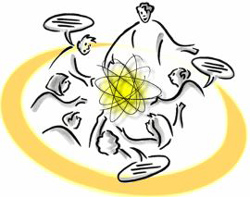
The word "facilitate" doesn't mean to lead, control, or direct. Facilitate simply means to make easier. In a practical sense, the job of a facilitator is to help create a space that is comfortable and productive for a group of people. Facilitating is like adding oil to a car. Facilitators make meetings, discussions, and events of all sorts run smoothly.
Here are some tips on facilitating:
Setting the Tone
The opening stage of any session is a good time for setting the tone and establishing group norms. Facilitators are carefully watched for signs of behaviour that is appropriate or inappropriate, so lead by example and use this time to introduce and model appropriate types of behaviour.
Stay Neutral
You should avoid sharing a strong opinion; as a facilitator, if you want to say something, call on yourself in turn, but make sure you don't use your role to dominate the discussion. Furthermore, you should not allow people with race, class, gender, or other subtle or non-subtle privilege to dominate a meeting. As a facilitator, you should encourage everyone to participate while moving the meeting along to meet time and agenda limits.
Andy Trainer
13 Aug 2012
Shaun is one of our lead Management trainers. He regularly runs our Management Skills, Leadership and Train the Trainer courses. In this blog post he draws on content from his Facilitation Skills course. If you want to know more about this topic then why not give us a call on 01273 622272? We will do our best to find you the most suitable course.

The word "facilitate" doesn't mean to lead, control, or direct. Facilitate simply means to make easier. In a practical sense, the job of a facilitator is to help create a space that is comfortable and productive for a group of people. Facilitating is like adding oil to a car. Facilitators make meetings, discussions, and events of all sorts run smoothly.
Here are some tips on facilitating:
Setting the Tone
The opening stage of any session is a good time for setting the tone and establishing group norms. Facilitators are carefully watched for signs of behaviour that is appropriate or inappropriate, so lead by example and use this time to introduce and model appropriate types of behaviour.
Stay Neutral
You should avoid sharing a strong opinion; as a facilitator, if you want to say something, call on yourself in turn, but make sure you don't use your role to dominate the discussion. Furthermore, you should not allow people with race, class, gender, or other subtle or non-subtle privilege to dominate a meeting. As a facilitator, you should encourage everyone to participate while moving the meeting along to meet time and agenda limits.
Andy Trainer
13 Aug 2012
The Johari Window model, devised by American Psychologists Ingham and Luft during a research period at the University of Los Angeles in 1955, is a behavioural model which aims to boost group relations through individual self awareness and mutual (group) understanding.
The model is a combination of the first names of Joseph Luft and Hari Ingham; they’re remembered over fifty years later which shows what good workplace relationships can achieve.
The Johari Window model is particularly useful in assessing group relations with other parties. Despite being published over fifty years ago, the model is still relevant in the work place today. This is due to current popular workplace emphasis on cooperation, inter-group development, interpersonal development, soft skills, behaviour and the influence of these factors.
The ease of using the Johari Window Model to understand relationships between employees and the employer within the Psychological Contract is an invaluable benefit to businesses.
What Does The Johari Window Mean?
The model is, on the face of it, is as simple as it appears. Its application in the workplace is slightly more tricky, but we’ll get to that later.
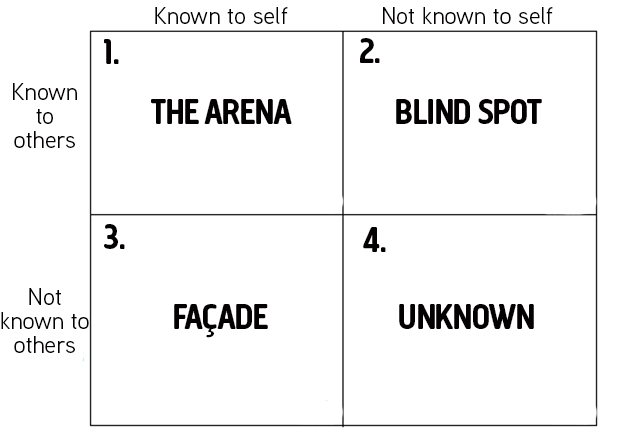
Andy Trainer
14 Nov 2014